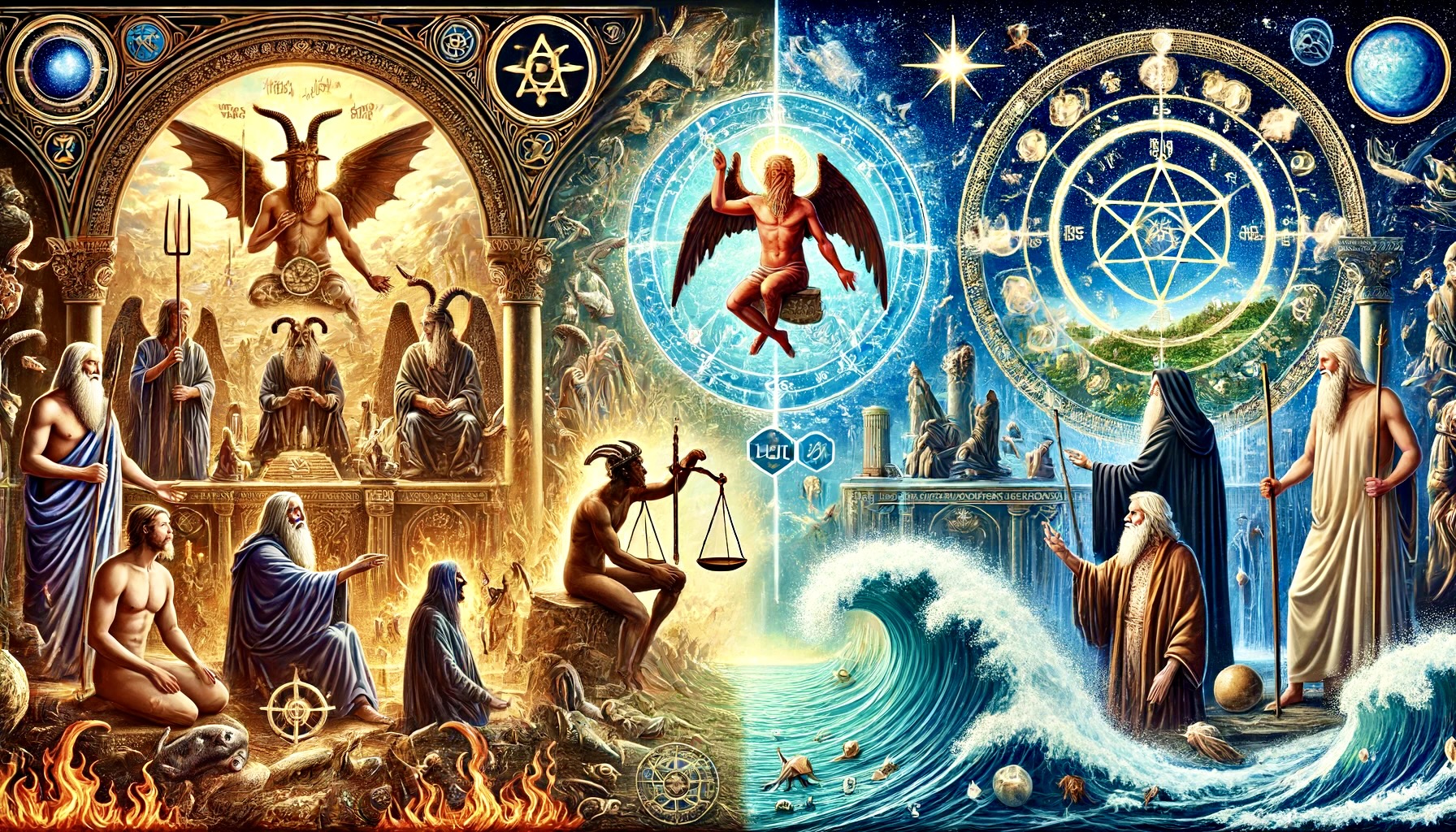Satan in Hebrew Scripture
Within the rich tapestry of the Hebrew Scriptures, the figure of “the satan” is not the embodiment of evil as later Christian interpretations suggest. Instead, it is an adversary or opponent, often sent by G-d to challenge and test individuals. This is evident in the story of Job, where “satan” is depicted as a member of the divine council, whose role is to test Job’s righteousness.
Specifically, “Satan” in Hebrew means “adversary” or “accuser.” Generally, this role serves as a tool for growth and understanding through opposition. Hence, in this light, “the satan” acts as a divine messenger, an instrument through which individuals are refined and their faith and character tested.
Piscean Age
The age of Pisces, spanning roughly from 1 CE to the early 21st century, characterized by duality and dichotomy, where light and darkness, good and evil, were in constant tension and needed to be clearly delineated was a period in mankind’s evolution where a more dualistic view was necessary. Humanity was developing its moral compass, understanding the distinctions between right and wrong, and forming social structures based on these moral distinctions. The clear demarcation of good and evil, personified through figures like the Christian “Satan,” helped people navigate their ethical landscape. This assisted in encouraging societal cohesion and moral development. This framework provided a means to understand and confront the trials and tribulations of life, attributing them to external forces that needed to be battled and overcome.
Furthermore, the Piscean age, influenced by the astrological symbol of the fish, emphasized hierarchies, machines, and the illusion of separation from nature and from each other. In this context, the Christian’s interpretation of “Satan” played a crucial role in highlighting the difficulties of temptation and moral challenges. The externalized force gave human beings a focal point for developing an awareness of contrast.
It is tempting to cling to the dualistic version of the Church’s “Satan” because it fuels us creatively and poetically. The stark comparison between good and evil is dramatic and exciting, making for compelling stories and vivid imagery. It allows us to virtue signal or condemn others easily, positioning ourselves on the side of righteousness while blaming an external source for the evils we see and experience. This externalization of blame can be comforting, as it removes personal accountability and the need to confront our inner shadows.
The Piscean era’s focus on duality is mirrored in religious, philosophical, and cultural narratives.
Examples:
– **Religious Narratives**: Christianity, with its clear delineation of Heaven and Hell, G-d and Satan, embodies the dualistic worldview. Satan’s role as the tempter in the Garden of Eden and the persecutor in the Book of Revelation reinforces the concept of a cosmic battle between good and evil.
– **Philosophical Discourses**: Philosophers like Saint Augustine emphasized the binary of divine grace versus human sinfulness, highlighting the struggle to overcome inner and outer adversaries.
– **Cultural Expressions**: Literature, art, and folklore from the Piscean age frequently depict epic battles between heroes and villains, angels and demons, embodying the era’s dualistic ethos.
During the age of Pisces, “Satan” served as a crucial figure in humanity’s quest for moral clarity and spiritual growth. By confronting external adversaries, individuals could navigate their ethical landscapes, form cohesive societies, and cultivate inner strength.
Transitioning
However, as we transition into the Age of Aquarius, the symbolism of “Satan” bifurcates our worldview. The Age of Aquarius, which is thought to have begun in the early 21st century, is marked by a shift towards integration, unity, and a higher consciousness. The dualistic framework that served humanity in the Piscean age, emphasizing the struggle between opposites, gives way to a more holistic understanding of existence. From this perspective, adversities are not just obstacles but opportunities for growth and integration. This version leads to introspection and a moral clarity that are vital for personal and collective growth during this era.
In this new age, the concept of “the satan” evolves. Rather than viewing challenges as external oppositions, we can begin to see them as integral parts of our inner journey towards wholeness. The adversary is not an external force to be battled but a reflection of our own inner conflicts and dualities that need to be reconciled. This integrated perspective encourages us to embrace our full humanity, acknowledging both our light and shadow aspects. It is from this point of view that we may look to find harmony within ourselves.
Aquarian Age
The Age of Aquarius emphasizes knowledge, innovation, and the collective good. This era encourages the breakdown of old structures and the creation of new paradigms. These new paradigms are based on interconnectedness and a more holistic understanding. The evolution of “the satan” in this context reflects a deeper comprehension of adversities as catalysts for personal and societal transformation.
The shift from the age of Pisces to Aquarius invites us to move beyond the dichotomy of good versus evil. It encourages us to understand the interconnectedness of all experiences. Challenges and adversities, symbolized by “the satan,” can be seen as essential elements in our spiritual evolution. In turn, this can guide us towards greater self-awareness and unity. This is evident in various emerging trends:
Examples:
– **Psychological Insights**: Modern psychology, especially Jungian analysis, views the “shadow” self as a critical aspect of the psyche that must be acknowledged and integrated for personal growth.
– **Spiritual Practices**: Contemporary spiritual movements emphasize mindfulness, inner peace, and the integration of all aspects of the self, moving away from the fear-based narratives of dualism.
– **Collective Consciousness**: There is a growing awareness of global interconnectivity and the need for cooperation and understanding, reflecting the Aquarian ideals of unity and collective well-being.
In conclusion, while the concept of “Satan” as a malevolent entity in opposition to G-d was a powerful tool for understanding human struggles in the Piscean age, the Aquarian age calls for a more integrated approach. We are invited to transcend duality, to see challenges as opportunities for growth, and to embrace a more unified, holistic understanding of our spiritual journey. As we do so, we move closer to the divine harmony that underlies all of creation.
Thank you for your time and attention, my dear friends and fellow humans.


